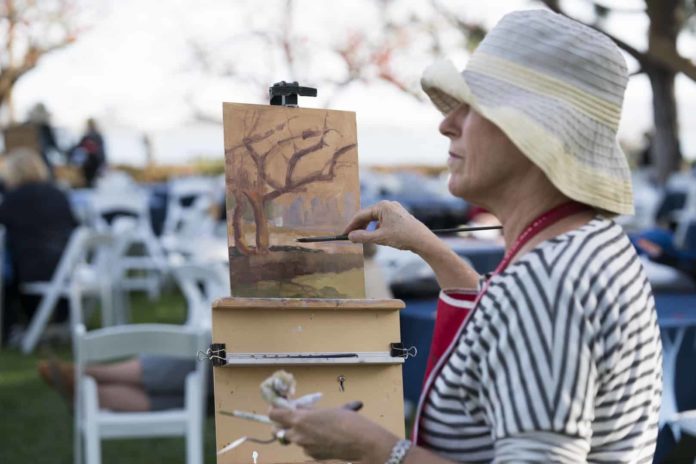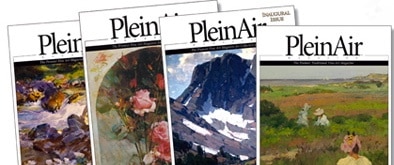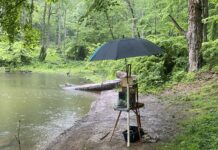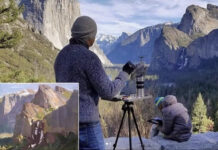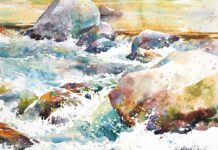What to Find in the Ultimate Plein Air 101 Guide:
• What is plein air painting?
• How do you pronounce “plein air”?
• Why plein air painting?
• What do you need for plein air painting?
• What is the best plein air easel?
• When is the best time to paint outdoors?
• Where should you practice plein air painting?
• What is a plein air festival?
• Plein air vs. urban sketching
• Plein air vs. studio
• What is a nocturne painting?
Click here to subscribe to the free newsletter, PleinAir Today
What Is Plein Air Painting?
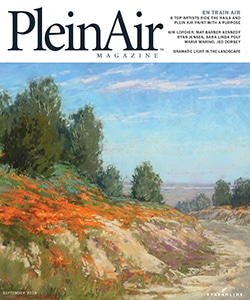
If you’re an artist, chances are you’ve already practiced plein air painting and maybe don’t even realize it! Some artists paint en plein air for years before realizing they’re part of the world’s largest art movement.
Simply put: Plein air painting is the same as painting outside. Thousands of artists have begun this practice by taking their supplies into cities and urban areas to reflect the hustle and bustle of people in their daily lives, as well as to the mountains, streams, forests, and deserts to capture the magnificence of nature on canvas.
“I’ve been involved in the arts for more than 20 years, and one of the most exciting phenomena to happen in that time has been the explosion of interest in painting outdoors,” says Kelly Kane, editor of PleinAir Magazine.
“Plein air is possible for anyone with a desire for adventure and a love of art.” ~Carrie Curran
How Do You Pronounce “Plein Air”?
The phrase “plein air” is a French term that means “outside.” You’ll hear people pronouncing “plein air” in a couple of different ways: “plen” with a soft “e,” or “plane” with a long vowel sound, as in airplane. In our community, either is accepted.
If you’re still unsure, take a moment to listen to one of our popular PleinAir Podcasts with Eric Rhoads. You’ll find a complete list of the PleinAir Podcast episodes here. Simply choose from your favorite artists!
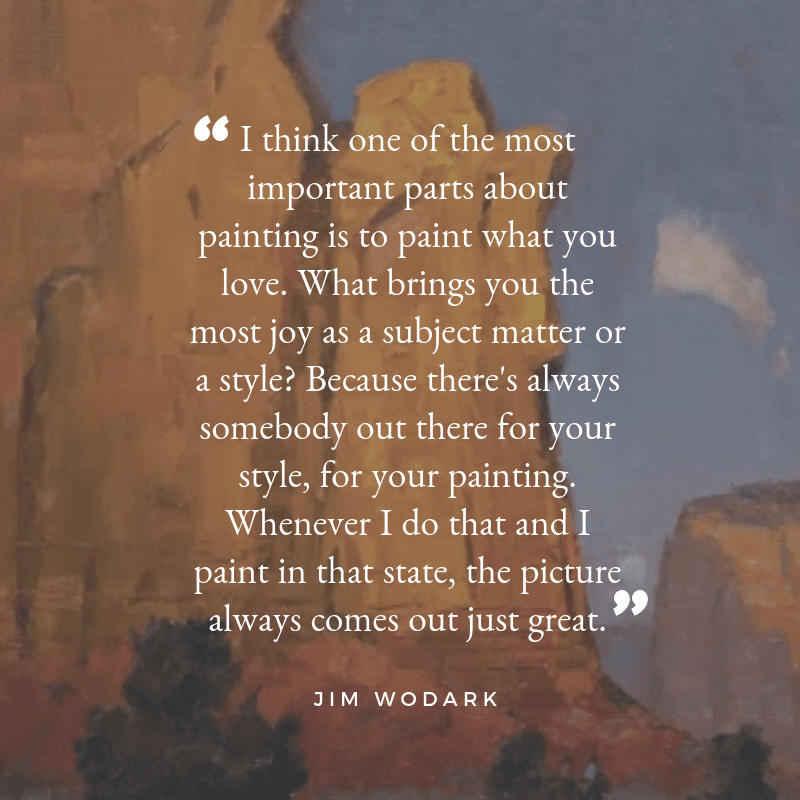
Why Plein Air Painting?
Outdoor painters love plein air for many reasons. One of the most common is the act of being outside and connecting with nature, along with the fact that when painting outdoors, one must make quick decisions about elements such as composition and color. Working quickly keeps you in the moment and lets you get the essence of the scene onto your canvas before the light or other factors change.
Some artists consider the painting complete the moment they pack up their gear. Others will finish their work in the studio with their studies and photo references — there is no wrong way.
To learn more about this movement, watch our “Outside the Lines” documentary, from the publishers of PleinAir Magazine:
.
Click here to subscribe to the FREE newsletter, PleinAir Today
What Do You Need for Plein Air Painting?
For painting outdoors, you’ll obviously need your art supplies, such as your watercolors / oils / pastels / acrylics / drawing tools, brushes, and your substrates — canvases, paper, etc. But in addition to these basics, many artists bring the following for painting outdoors:
- Umbrella, hat, sunblock, and bug spray
- Paper towels and rags
- A chair or stool, drinking water, and a snack
For a more in-depth list, check out this related article > Must-Have List: Crucial Outerwear and Art Supplies
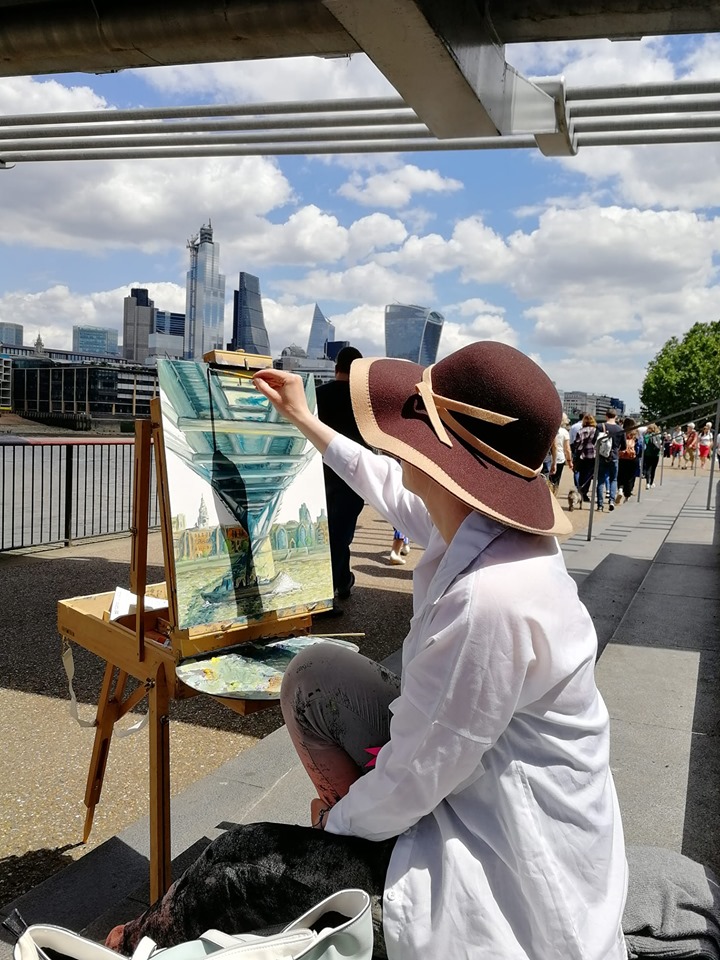
What Is the Best Plein Air Easel?
There are many easels and paint boxes on the market today, and choosing the right one for you will depend on a variety of factors. If you tend to paint in a windy location, for example, you’ll want to make sure you’re using an easel that can take the wind. Another thing to consider is how big of a canvas you usually use.
Consider visiting your local art supply store to view the easels and talk with the salesperson about your needs. We also asked our audience which easel they use and why. See their responses in the article “The Best Plein Air Easels for Artists.”
Related Articles >
• Building the Perfect Easel (Reasonably) Easily and Affordably
• Choosing the Right Paint Box
When Is the Best Time to Paint Outdoors?
“The best times to paint outdoors are in the morning and afternoon,” says Carrie Curran. “The light is best at these times because you will have contrast, strong color, and shadows that aren’t changing as quickly. You can paint for two to three hours starting about an hour after sunrise and in the afternoon ending an hour before sunset. The golden hour, right after sunrise and sunset, produces beautiful, glowing light, but the light changes quickly.”
“Make sure the weather conditions are to your taste,” she adds. “Scheduling with friends, especially when venturing to remote places, is a good practice.”
When it comes to the best time of day for painting outdoors, Suzie Baker counters, “The best time to paint? How about bad times to paint? Namely, when you are hungry, missing crucial supplies, or have to pee! Which is why the savvy artist needs to remember the 4P’s: Painting (the View), Parking (to trek back to grab that panel you forgot), Potty (or a sneaky place to potty) and Phood (what?! I made it work).”
Where Should You Practice Plein Air Painting?
“Site selection is important,” Curran says. “Choose subjects that interest you, and find places you can easily return to for further study, like Monet did. Upon arrival, leave your gear and take your sketchbook for notes and walk around observing and looking for elements to create simple compositions.”
All in all, just about any location is an option for painting outdoors. If you find an irresistible view that happens to be on private property, get permission before setting up. Also make sure that you’re in a location that’s safe in regards to not only other people, but also wildlife.
What Is a Plein Air Festival?
Attending a festival is a wonderful way to network and make new friends in the art community. A plein air festival is simply a gathering of outdoor painters, with many variations on how the events are held and run. These are held regionally throughout the year, and are usually organized by a local art group. At a festival, artists will gather at a specific location to paint together, or they may wander to a nearby spot where they’ve found the ideal landscape view.
Some of the best-known festivals include Plein Air Easton (Maryland), Olmsted Plein Air (Georgia), and the Laguna Beach Plein Air Painting Invitational (California), to name just a few. The annual Plein Air Convention & Expo (PACE) is another event for artists you may want to consider – it’s the largest gathering of plein air artists in the world, bringing together more than 80 of today’s most accomplished painters.
Listen to the following PleinAir Podcast, featuring Al Bond and Jess Bellis, to learn more about what it’s like to participate in a festival:
.
Bonus: Click here for our free guide to events and organizations!
Plein Air vs. Urban Sketching
What’s the difference between plein air painting and urban sketching? The answer comes down to style and media, but opinions will vary depending on who you ask because it’s like some things — hard to define, but you know it when you see it. Back to the style and media…
Most urban sketchers use a combination of ink (pens and markers) and watermedia (watercolor being the most common). The subjects are often defined by the inky lines that block in the shapes of an urban setting, including buildings, parks, and people, for example. Color is typically added in a loose way to help capture the scene and further define the shapes. Urban sketchers share their work and get together all over the world, connecting through a site called Urban Sketchers.
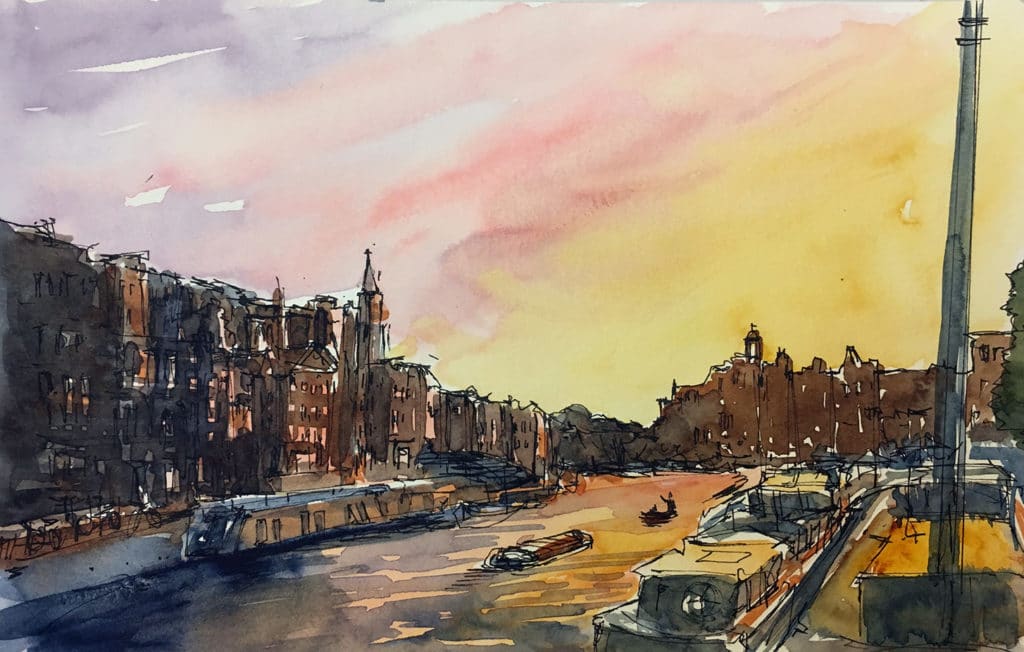
Like with urban sketchers, outdoor painters have some basic things in common but are unique within the larger group. A plein air painting is often a landscape that focuses on nature, highlighting elements such as mountains, trees, rivers, lakes, skies, and sometimes wildlife. But you’ll also find plenty of plein air works that have buildings and people as the subject. The defining aspect is that the painting is created outdoors, on location. Even this can vary, though, as many artists will also take their outdoor studies into the studio to finish the work.
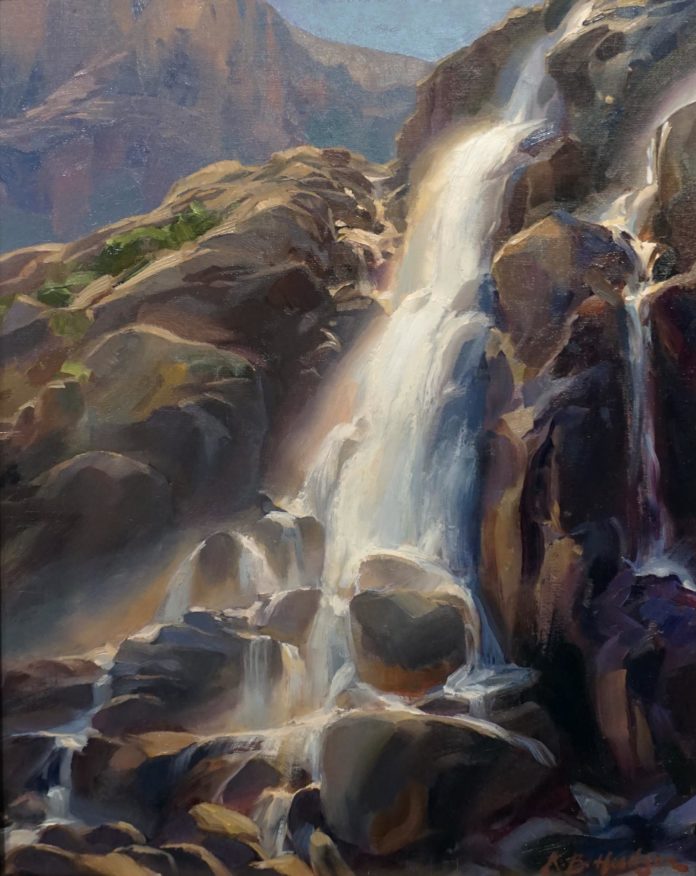
Regarding media, plein air paintings are often created in oil (shown above), as well as pastel, watercolor, or even acrylic.
When it comes to plein air vs. urban sketching, perhaps the most simple way to think of it is this: plein air painting and urban sketching.
Click here to subscribe to the FREE newsletter, PleinAir Today
Outdoors vs. Studio
Why would someone choose plein air vs. studio painting? Let’s start by defining the difference. Many artists choose to paint “on location” because they love to be outside in nature, to experience the challenge of creating a piece of art within the unpredictable elements, and to capture the stunning light of a beautiful sunset or sunrise, for example.
Some artists will begin their landscape painting outdoors by creating value studies and compositional sketches, taking notes on elements they’ll want to incorporate later, either in the same location or in the studio along with photo references.
The landscape perfectly lends itself to plein air paintings, but artists who prefer to paint the figure or still lifes most often work in an art studio, where elements such as lighting and exact subject matter are better controlled and recreated for multiple painting sessions.
In the end, it’s a personal choice that’s up to you to manifest for your next painting.
What Is a Nocturne Painting?
In regards to art and painting, a nocturne is a picture of a night scene. Nocturnes can be painted on site outdoors or in the studio from a photo reference.
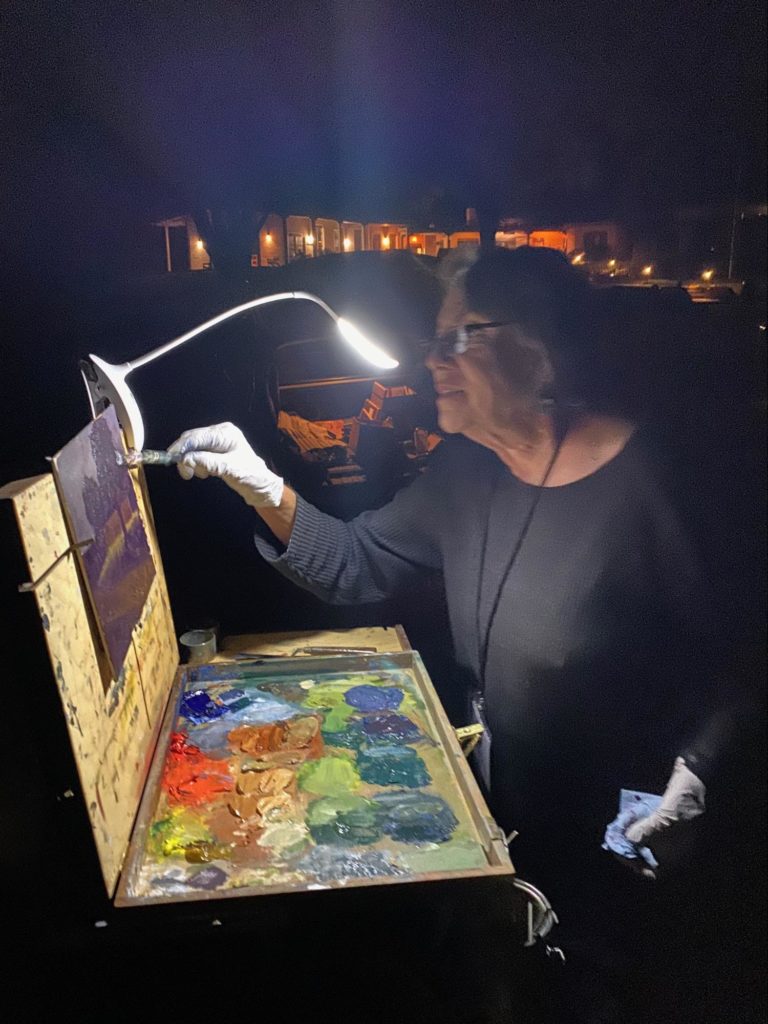
Kelly Kane, editor-in-chief of PleinAir Magazine, explains how the term came to be: After years of painting outdoors, James Abbott McNeill Whistler launched a series of night paintings based on careful observation and memory. Originally, he called these pieces “moonlights,” but an imaginative patron suggested the musical term “nocturnes” instead. The artist agreed, saying that the name “does so poetically say all that I want it to say and no more than I wish.”
Listen to this PleinAir Podcast with Eric Rhoads, featuring Jake Gaedtke, who addresses painting nocturnes:
.
> Click here to subscribe to the free newsletter, PleinAir Today
> And click here to subscribe to PleinAir Magazine so you never miss an issue!

